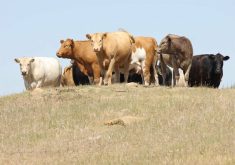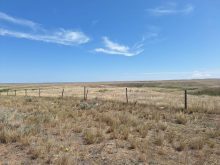Our prairie ecosystem evolved in merely 15,000 years following the Pleistocene glacial meltdown.
Today, the Arctic cap continues melting. Will that plunge our prairies back into a big freeze, forcing rapid evolution of our farming systems?
People who study the animated depiction of Arctic jet streams think the cold fronts we’ve experienced in the past five years may be the wave of the future. One of those people is Ken Greer, chair and principal owner of Western Ag in Saskatoon. He studies polar vortex animations because part of his job for his clients is delving into the future, in a quest for crops they might grow in years to come.
Read Also

Growing garlic by the thousands in Manitoba
Grower holds a planting party day every fall as a crowd gathers to help put 28,000 plants, and sometimes more, into theground
“I’ve watched this jet-stream animation tool of the Arctic Circle for 15 years. Historically, the polar jet stream was a continuous flow rotating around the Northern Hemisphere, tied to the North Pole as the axle.
“What we’ve seen lately, in the last four or five years, is that jet stream is broken. There’s all these cold weather eddies that break off and come hurling down across North America, especially the Canadian Prairies, but also northern Russia. Normally, our jet streams flow west to east. These cold eddies flow from north to south. That’s where all this driving cold comes from.
“Previously, that mass of polar ice served to hold the jet streams up at the Arctic Circle, almost like a magnet or like gravity pulling them closer to the North Pole in a continuous circle. When you take some of that polar ice out of the machine, it’s like taking a wheel bearing out of a hub. Now the assembly starts to shake and wobble and throw off pieces of the tire.”
The polar ice almost behaves as a source of gravity, in much the same way the sun keeps the planets in a reliable rotation.
As we move into summer, the jet stream previously settled into a reliable west-to-east pattern, pulling warm Pacific air up from the south, rather than pulling arctic air down from the north. Today, polar vortexes come down on us 12 months of the year, like a big angry polar bear giving the Prairies a punishing swat.
“This is all part of global climate change, buddy. It might be global warming on average, but variability is the kicker. The variance between the warmest of the warm and the coldest of the cold will be tremendous. Farmers need to figure out how to adapt to these wild weather swings.
“To survive these wild weather fluctuations, we’re looking at fall-seeded crops like winter lentils, rye, winter wheat, winter barley, winter peas, winter canola. Crops that have better adaptation to temperature swings.”
The concept of fall-seeded crops developed in Russia where farmers and plant breeders long ago had been forced to come to grips with long winters and compressed growing seasons. If you couldn’t develop a variety that matures in two months, the next best thing was to develop a variety you plant in the fall, so it’s ready to get back into business whenever spring decides to arrive.
If spring is delayed, a fall-seeded crop is dormant so it really doesn’t care. If spring is early, all that much better for everybody.
Greer says the beauty of fall-seeded crops is they reduce the risk associated with weather, be it a late spring as we have now or a very dry spring with no soil moisture, in which case the young plants can go deep and suck up enough moisture to survive until rain arrives.
A study in Washington State showed that fall-seeded dry peas were able to survive winter and pop back to life in spring. According to Washington State University agronomist Stephen Guy, “There are winter pea lines and autumn-sown pulse varieties that rival winter wheat in cold tolerance. Winter pea is an excellent rotation crop for winter wheat. Most places where winter wheat will survive, good varieties of winter pea will survive when managed properly.”


















